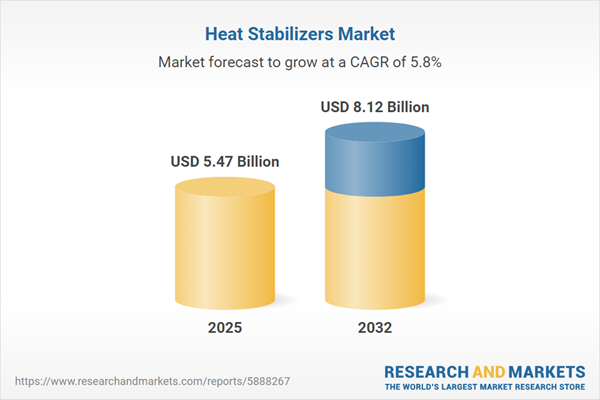Speak directly to the analyst to clarify any post sales queries you may have.
Senior executives in the heat stabilizers market are navigating transformative industry shifts defined by regulatory complexity, supply chain volatility, and rising sustainability mandates. Access to targeted, up-to-date market intelligence enables decision-makers to address compliance obligations, protect against operational risk, and advance growth strategies.
Market Snapshot: Trends and Outlook for the Heat Stabilizers Market
The heat stabilizers market is experiencing steady growth, propelled by the expanding use of high-performance plastics in automotive, construction, and healthcare applications. The current market size and a stable CAGR reflect this increasing demand. Ongoing innovation focuses on refining chemical formulations for improved material safety, compliance, and durability. Bio-based stabilizers and advances in nanotechnology are drawing heightened attention, as companies respond to stronger sustainability targets and evolving regulations. Regional regulatory standards, especially in North America, Europe, and select Asia-Pacific markets, are notably stringent, requiring frequent product adaptation and innovation to ensure manufacturers maintain competitive and compliant product portfolios.
Scope & Segmentation of the Heat Stabilizers Ecosystem
For top-level leaders, a comprehensive understanding of the heat stabilizers ecosystem is vital to make informed procurement, investment, and compliance decisions. Key segments and technologies shaping the market include:
- Product Types: Solutions including calcium zinc, liquid phosphite, metal soap, organotin, and solid phosphite stabilizers, each suited to specific durability and compatibility standards across varied industries.
- End Use Industries: Automotive, construction, healthcare, food packaging, protective packaging, and wire and cable sectors all impose unique technical and regulatory requirements, shaping material selection and influencing supplier strategy.
- Application Processes: Processes such as blow molding, calendaring, extrusion, and injection molding necessitate tailored stabilizer properties, directly impacting operational efficiency and integration of manufacturing systems.
- Form Options: Granular, liquid, paste, and powder forms available to suit diverse manufacturing workflows, offering operational flexibility and scalability.
- Grades: Choices among industrial, medical, and food-grade stabilizers allow compliance with sector-specific safety and application benchmarks.
- Regional Coverage: Activity spans North America, South America, Europe, the Middle East, Africa, and Asia-Pacific markets, with innovation hubs in the United States, Germany, China, and Brazil influencing technological advancements and supply planning.
- Key Players: Market leadership and product strategy are influenced by Baerlocher GmbH, Adeka Corporation, Solvay SA, BASF SE, Clariant AG, Songwon Industrial Co., Ltd., Ferro Corporation, Alberdingk Boley GmbH, Milliken & Company, and Akrochem Corporation.
Key Takeaways: Strategic Insights for Senior Leadership
- Building resilient supply chains calls for diversified sourcing and multiple supplier relationships to maintain operational continuity during disruptions.
- Procurement is shifting toward bio-based and non-heavy metal stabilizers, driven by health, sustainability, and global environmental initiatives.
- Digital manufacturing and the adoption of nanotechnology enable organizations to optimize stabilizer characteristics, improving efficiency and production agility.
- Each sector brings specific requirements, with healthcare focusing on product purity and patient safety, and automotive and construction prioritizing long-term material reliability.
- Compliance demands encourage continuous differentiation through enhanced support, innovation, and value-added product features.
- Quality assurance standards are rising, particularly in medical devices and specialty wiring, leading to increased investment in validated manufacturing processes.
Tariff Impact: US Trade Policy and Market Effects
Recent changes in US tariffs are prompting businesses to forge stronger ties with domestic heat stabilizer providers, while exploring new international sourcing opportunities. These developments place a premium on flexible procurement strategies and real-time monitoring of cost structures for all industry participants.
Methodology & Data Sources
This analysis draws on direct interviews with specialty chemical experts, detailed product validation exercises, and comprehensive reviews of patent and regulatory filings. Industry feedback ensures the findings reflect executive strategic requirements and ongoing market evolution.
Why This Report Matters
- Offers actionable market segmentation for leaders shaping objectives and innovation strategies to address regulatory and sustainability demands.
- Supports robust supply chain and procurement planning, strengthening resilience and regulatory alignment within dynamic regional markets.
- Guides targeted investment through deep insight into segment trends, technology preferences, and market leadership in the heat stabilizers sector.
Conclusion
This report delivers senior executives the insight essential to resolve regulatory and supply chain challenges, supporting strategic decisions aimed at sustainable growth and innovation in the heat stabilizers industry.
Additional Product Information:
- Purchase of this report includes 1 year online access with quarterly updates.
- This report can be updated on request. Please contact our Customer Experience team using the Ask a Question widget on our website.
Table of Contents
3. Executive Summary
4. Market Overview
7. Cumulative Impact of Artificial Intelligence 2025
Companies Mentioned
The companies profiled in this Heat Stabilizers market report include:- Baerlocher GmbH
- Adeka Corporation
- Solvay SA
- BASF SE
- Clariant AG
- Songwon Industrial Co., Ltd.
- Ferro Corporation
- Alberdingk Boley GmbH
- Milliken & Company
- Akrochem Corporation
Table Information
| Report Attribute | Details |
|---|---|
| No. of Pages | 181 |
| Published | November 2025 |
| Forecast Period | 2025 - 2032 |
| Estimated Market Value ( USD | $ 5.47 Billion |
| Forecasted Market Value ( USD | $ 8.12 Billion |
| Compound Annual Growth Rate | 5.8% |
| Regions Covered | Global |
| No. of Companies Mentioned | 11 |









